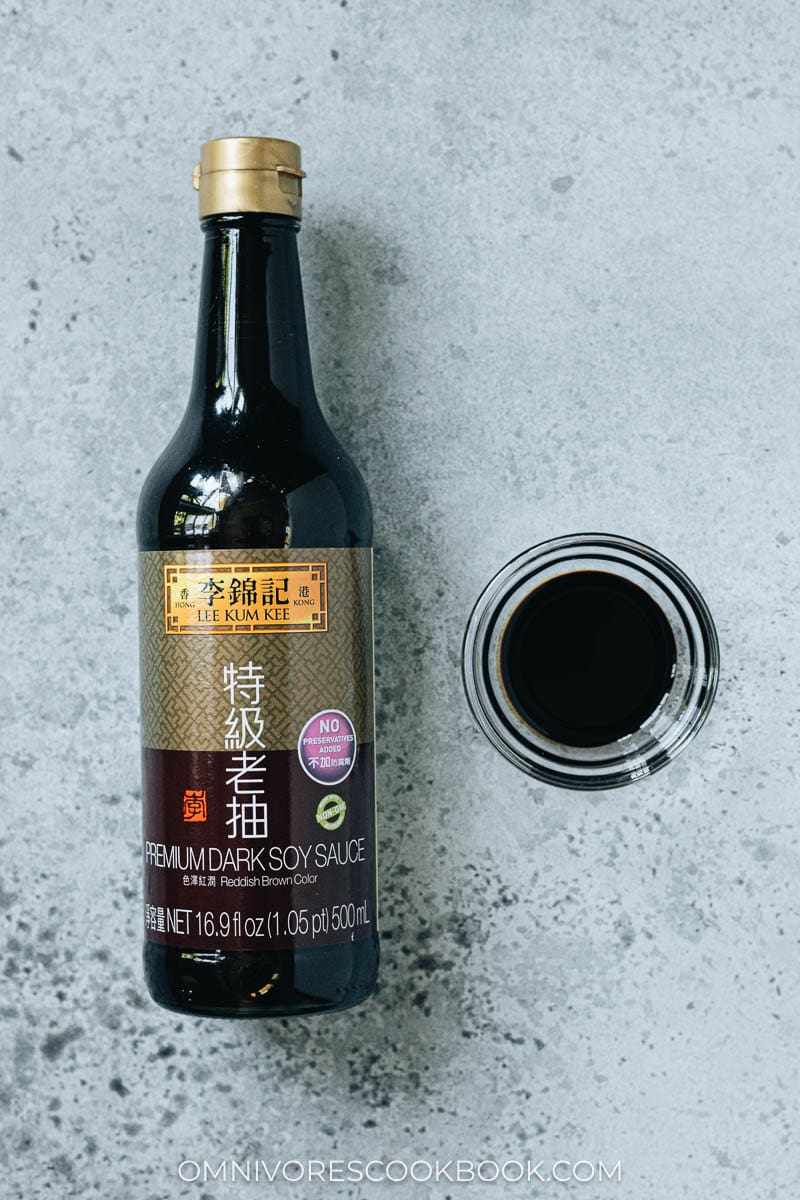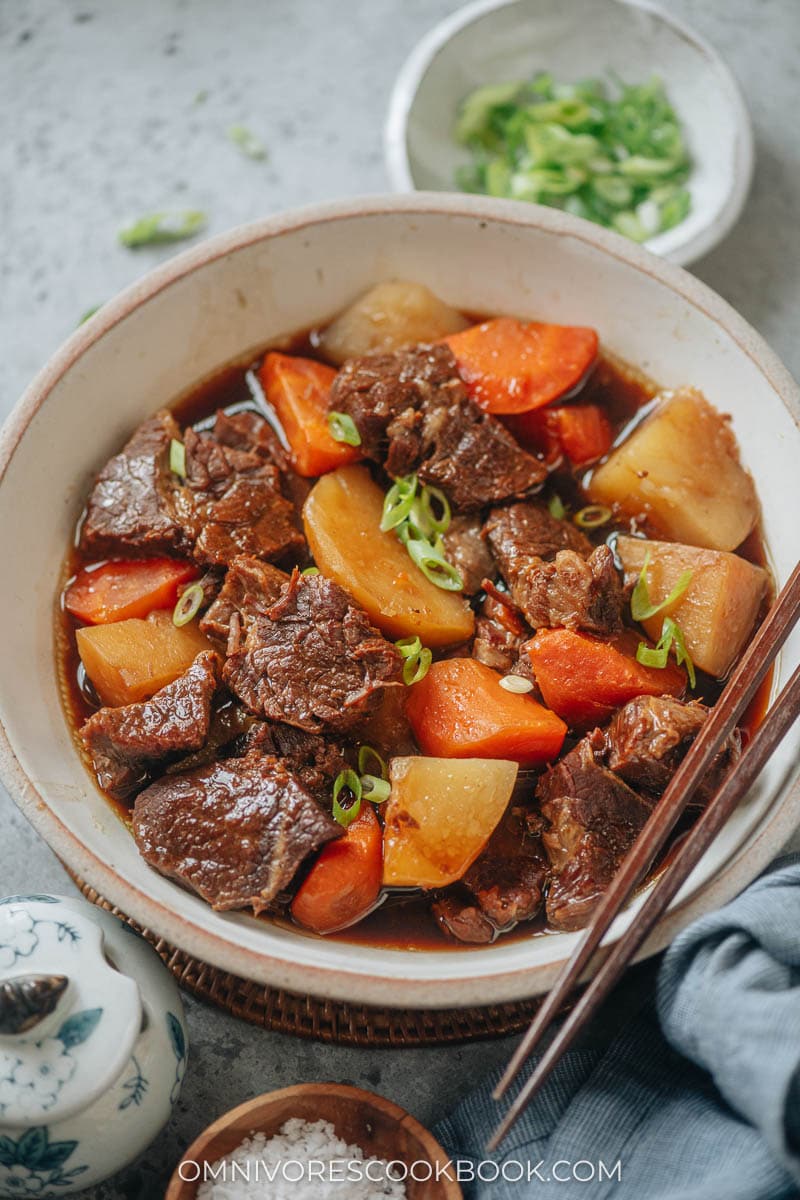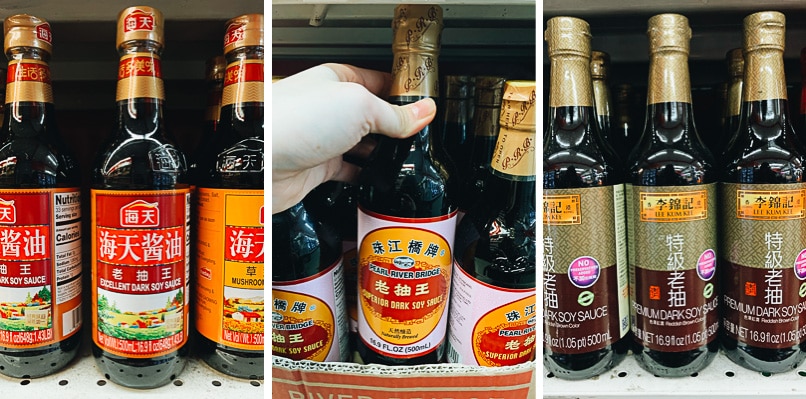Dark Soy Sauce (老抽, lǎo chōu) is a particular kind of soy sauce that is critical for making delicious, authentic Chinese dishes, many of which you probably already know and love.
This is my deep dive into dark soy sauce. I’ll tell you what makes this ingredient special and how you can use it to nail your favorite Chinese flavors.

Table of contents
- What is Dark Soy Sauce?
- How is dark soy sauce made?
- What does dark soy sauce taste like?
- Uses
- How to shop for dark soy sauce
- How to store
- Substitutes for Dark Soy Sauce
- Frequently Asked Questions
- Is dark soy sauce actually less salty than light soy sauce?
- I need to watch my sodium intake – can I still use dark soy sauce?
- What is mushroom dark soy sauce? Is that the same thing?
- Can you recommend a gluten-free dark soy sauce?
- Why do so many dark soy sauces contain preservatives?
- Can I use dark soy sauce instead of light soy sauce?
- Recipes Using Dark Soy Sauce
What is Dark Soy Sauce?
Dark Soy Sauce is a dark-colored and slightly thick type of soy sauce. Compared to light soy sauce and soy sauce, it is more viscous, a bit sweeter, and slightly less salty tasting.
It is typically used to add a striking glossy dark brown color to stir fried dishes and a deep, complex savory essence to braised dishes and marinades.
Frequently, dark soy sauce is used together with light soy sauce, to create a rich, layered umami. For this reason, it’s important to have both light and dark soy sauce in your pantry when cooking authentic Chinese food.
How is dark soy sauce made?
Dark soy sauce is made much like light soy sauce is, though there are some differences in the final stage that help create the dark variety’s signature color, flavor, and consistency.
Here’s an overview of the process:
- Cooking – Soybeans are steamed or boiled until soft. Whole wheat berries are roasted until dark brown and then coarsely ground.
- Mixing and mold introduction – While the soybeans are still warm from cooking, they’re combined with the crushed roasted wheat. Certain molds are introduced to the mixture to enable fermentation.
- Fermentation – The solid mixture is allowed to ferment briefly before being combined with water and sea salt for a longer fermentation. The molds break down the carbohydrates and proteins of the soy and wheat into simpler compounds, including the glutamates that give soy sauce its unmistakable umami. Naturally occurring microorganisms also contribute to the fermentation and flavor development. This step can last from a few months to several years.
- Pressing – The fermented mixture is pressed through cloth to extract the flavorful liquid from the solids in the mixture.
- Reduction and Blending – To get the thicker, more concentrated liquid of dark soy sauce, the pressed liquid may be cooked or allowed to evaporate a bit. Additional ingredients are added to it, usually caramel and/or sugar, and sometimes mushroom.
Whether your dark soy sauce is artisanally made or mass-manufactured, if it’s a brewed soy sauce, it undergoes this basic process.
What does dark soy sauce taste like?
The flavor profile of dark soy sauce is characterized by a robust earthy umami, gentle sweetness, and subtle bitterness. Due to the thicker consistency, the flavor may stick to the taste buds a bit more than light soy sauce.
Uses
Dark soy sauce is most often used in these ways:
- It can be used in a stir fried dish to lend its beautiful reddish-brown color and a bit of caramelly umami. Dark soy sauce gives your favorite takeout style fried noodles and stir fry that irresistible glossy, brown, savory coating.
- Or it can be used in a braised dish to lend its deep earthy umami as a complement to the fresher, brighter umami of light soy sauce.
Less commonly, dark soy sauce can be used in a dipping sauce, to add a nice brown color without adding too much extra volume. I like to add a touch of it to chinkiang or rice vinegar to make a dumpling dipping sauce – the savoriness and sweetness provide a bit of balance.


How to shop for dark soy sauce
The easiest places to find a basic dark soy sauce will be your local Asian market or online.
As for brands, here are some of my favorites:
- Pearl River Bridge Superior Dark Sauce (珠江桥牌) – this is my go-to general purpose dark soy sauce. It should be around $3 if purchased locally.
- Zhongba Dark Soy Sauce (中坝) – this is a bit of a splurge, but if you’re looking for something special, the depth of flavor is unbeatable. It contains a bit of mushroom to boost the flavor, but the mushroom doesn’t stand out, so this is not a “mushroom dark soy sauce”.
- Lee Kum Kee Premium Dark Soy Sauce (李锦记), HaiTian Dark Soy Sauce (海天), and Kimlan Lou Chau Soy Sauce (金兰) are reliable, quality brands that are fairly common.
If you end up buying another brand, look for the Chinese characters “老抽” (lǎo chōu) on the bottle. This will help ensure you have the right kind of dark soy sauce for Chinese cooking.

How to store
You should store your dark soy sauce in a cool, dark cabinet or cupboard. An unopened bottle is good for a couple of years, and a bottle should be used within 6-12 months of being opened.
Substitutes for Dark Soy Sauce
If I’m being blunt, there is no substitute for dark soy sauce. It’s an essential ingredient for Chinese cooking and is worth keeping on hand if you want to cook authentic Chinese food.
However, I understand that you might be in a pinch and want to cook a recipe that calls for dark soy sauce. Here are some possibilities:
- Skip the dark soy sauce or replace it with light soy sauce or regular. This is usually OK if the amount is 1/2 teaspoon or less. You might stir in a pinch of brown sugar or molasses to get a bit of the sweetness of the dark soy.
- Replace it with oyster sauce. This is far from ideal, but if the dish you’re making contains seafood or is otherwise very umami and/or earthy, it should still be tasty.
For a gluten-free dish, I would use tamari to replace the dark soy sauce plus a tiny pinch of molasses or brown sugar.
I don’t recommend coconut aminos as a substitute for any kind of soy sauce.
Frequently Asked Questions
Is dark soy sauce actually less salty than light soy sauce?
I say that it’s “less salty tasting” above because it has a balancing sweetness that light soy sauce doesn’t have, so the saltiness stands out less. Dark soy sauce actually contains more salt (and therefore more sodium) than light soy sauce. This is the result of the evaporation at the end of the brewing process which makes dark soy sauce more concentrated.
I need to watch my sodium intake – can I still use dark soy sauce?
Yes, you can. Since dark soy sauce is almost always used with light soy sauce (and sometimes also with additional salt) you can reduce the amount of light soy sauce and/or salt to cut the sodium in the dish. Keep the amount of dark soy sauce the same.
What is mushroom dark soy sauce? Is that the same thing?
Mushroom dark soy sauce is a type of dark soy sauce with mushroom added, so the earthy umami is even more pronounced. It can be used in place of regular dark soy sauce and should be a tasty variation if you appreciate mushroom flavor.
Can you recommend a gluten-free dark soy sauce?
Lee Kum Kee makes a Gluten Free Premium Dark Soy Sauce, but unfortunately, it’s currently only available in a 64 oz (2-liter) bottle. For gluten-free substitutes, use a gluten-free (light) soy sauce / tamari or a gluten-free oyster sauce with the substitution guidance above.
Why do so many dark soy sauces contain preservatives?
Because of the sugar content of dark soy sauce, it’s more prone to spoilage than light soy sauce. Even high-end dark soy sauces may contain potassium sorbate or sulfur dioxide. However, Kimlan Lou Chau Soy Sauce is a quality dark soy sauce from Taiwan that is made without preservatives.
Can I use dark soy sauce instead of light soy sauce?
Not really. But if you’re really in a bind you might be able to pull it off. If the amount of light soy sauce called for is less than a teaspoon (assuming it’s a dish for multiple people) and if you don’t mind your dish being more darkly colored and slightly sweeter, it could be OK.
Recipes Using Dark Soy Sauce
- Soy Sauce Fried Rice and Soy Sauce Fried Noodles are two super simple pantry-basics recipes that show you the true beauty of dark soy sauce
- General Tso’s Chicken, Mongolian Beef, and Lo Mein – you’d be surprised how many American-Chinese recipes can be made tastier with dark soy sauce
- Beef Chow Fun and Drunken Noodles are two stir fried rice noodle dishes featuring a lovely savory-sweet dark soy glaze
- Marinated Tea Eggs are addictively tasty, thanks to the soaked-in umami of the dark soy marinade
- Hong Shao Rou is a classic braised pork belly that is meltingly tender and exploding with umami
- Braised Pork Trotters is a comforting homestyle recipe that turns a less desirable cut into a delicacy using dark soy sauce and aromatic herbs
Lu Rou Fan – a signature Taiwanese dish with pork belly, egg, and mushroom in a dazzling umami sauce over rice












